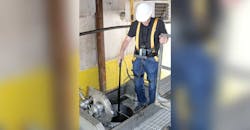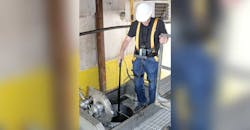Zistos’ video inspection, atmospheric monitoring systems help reduce dangers associated with working in confined spaces
ACCIDENTS happen.
Forest Gump didn’t even need to slow down to aptly express this aphorism, albeit in more colorful terms.
Why? Because we’re human, and humans make mistakes.
More specifically, in regard to accidents in industrial settings, people err, either by ignoring training or failing to follow safety procedures, for myriad reasons, including lack of information, misunderstanding risk factors, taking shortcuts to save time, overconfidence—It can’t happen to me!—distraction, preoccupation with other issues, improper preparation or safety gear, and the list goes on.
That doesn’t mean we must accept these mishaps, and resulting injuries, as inevitable.
Bob Levine certainly doesn’t.
The president of Zistos Corporation, a purveyor of portable video systems, introduced his company’s technology for monitoring work in and around confined spaces to attendees of the National Tank Truck Carriers’ Tank Truck Week 2018 in Nashville, Tennessee, during his presentation “Applying Technology to Minimize the Risk of Industrial Accidents in Tank Truck Carriers.”
“There has been much progress in the safety of workers involved with the tanker truck industry, but there still is much room for improvement,” Levine said. “New technology can be applied to further increase this trend.
“(It) can be used to help keep people from having to work in a dangerous environment, and can also be used to make sure they operate in safe fashion when they have to enter that environment.”
Save lives, not money
So why do many companies still resist adopting new technologies and methods?
Two words—time and money.
New tools necessitate new investments, and implementing new training and procedures requires long-term commitment and resources, and often involves a learning curve busy carriers don’t want to endure.
Levine isn’t here for the excuses.
He points out the cost of having an accident is much greater, and the associated downtime is far more devastating.
“The only thing that we can count on is, at some point someone is going to ignore training, safety equipment mandates and procedure, and put themselves at risk,” he said.
“You can’t count on training alone to keep people safe.”
Confined spaces are inherently unsafe for the people who work in and around them, no matter how much training they’ve received, thus they’re a primary cause of concern in the bulk transportation industry. Many threats exist, and when accidents occur, rescue and recovery often is equally treacherous.
“According to one National Institute for Occupational Safety and Health (NIOSH) study, where 100 fatal confined-space accidents were examined, 29% were supervisory staff—people who should have known better,” Levine said.
The same study found the primary reason for entering confined spaces was for routine maintenance(52%), followed by repair (23%), inspection (15%), object retrieval (6%) and fighting fires (4%).
So how do we make these spaces safer? By staying out.
Remote inspection
Remote video inspection can play a key role in reducing and sometimes eliminating the need for a worker to enter a confined space while conducting maintenance or repairs, or simply retrieving a tool.
“Exposing the workers to less risk leads to fewer accidents,” Levine said. “It’s a direct correlation.”
With remote inspection, typically via a camera on a stick or cable, a worker can look at equipment conditions, and make a judgement about what’s wrong and how to correct it, before entering the space, essentially putting eyes on the issue before sticking a face in a potentially toxic environment.
“The key word here is ‘look,’” Levine said. “That’s the first thing you need to do, regardless of what needs to be repaired.”
Cameras also provide the added benefit of enhanced vision.
Not only do they save eyes, they’re better than eyes, exceeding human visual capabilities to zoom in for increased detail, illuminating hazards related to residual heel, structural issues, foreign object, industrial hygiene and early signs of delamination, which is detectable by thermal imaging.
Cameras with ultraviolet illumination, when used with dyes, make things like animal droppings, and certain types of molds and funguses, fluoresce, and also can reveal the source of dangerous leaks.
“A cell phone that’s dropped into a tank will light up like a Christmas tree with thermal imaging,” Levine said.
By using a camera for the initial inspection, workers are alerted to hazards before going inside, and if issues are detected, entrants know what tools and materials to take with them, limiting the number of entries and exits—and it’s documented, via video and still images, for future reference.
Unavoidable entry
The Occupational Safety and Health Administration (OSHA) mandates atmospheric monitoring, but accidents related to atmospheric hazards, including asphyxiation, still occur due to complacency and carelessness.
Zistos has a solution for this problem as well.
“We can put in automated and redundant gas monitoring to safeguard against an individual who makes a mistake, and for any reason neglects to use his equipment and training to keep him and others safe,” Levine said.
He stressed these safeguards must be automatic, and not a skippable procedure.
Zistos achieves this goal by a patent-pending marriage between a gas monitor and the ladder needed for confined-space entry. The monitor at the top of the ladder sounds local and remote alarms when a toxin is detected—and also notifies management when an individual fails to follow procedure.
Unfortunately, Levine said, staying alive isn’t always motivation enough.
“This tattle-tale approach helps keep employees focused on their training and equipment, as they’ll know that an error will let everyone in proximity know they screwed up, and they’ll also get a talking-to from management,” Levine said.
Zistos also employs man-down sensors that support the efforts of the OSHA-mandated attendants who must accompany any worker inside a confined space, helping improve response time and providing an additional layer of safety in situations where the attendant isn’t sufficiently attentive.
“People are people,” Levine said. “They’re going to err in judgement and make mistakes. So we can use these new tools and technologies to reduce the number of entries required, and add automated and redundant systems to further increase safety. This technology can create a virtual safety net against human error.”
Visit zistos.com for more information.
About the Author
Jason McDaniel
Jason McDaniel, based in the Houston TX area, has more than 20 years of experience as an award-winning journalist. He spent 15 writing and editing for daily newspapers, including the Houston Chronicle, and began covering the commercial vehicle industry in 2018. He was named editor of Bulk Transporter and Refrigerated Transporter magazines in July 2020.


